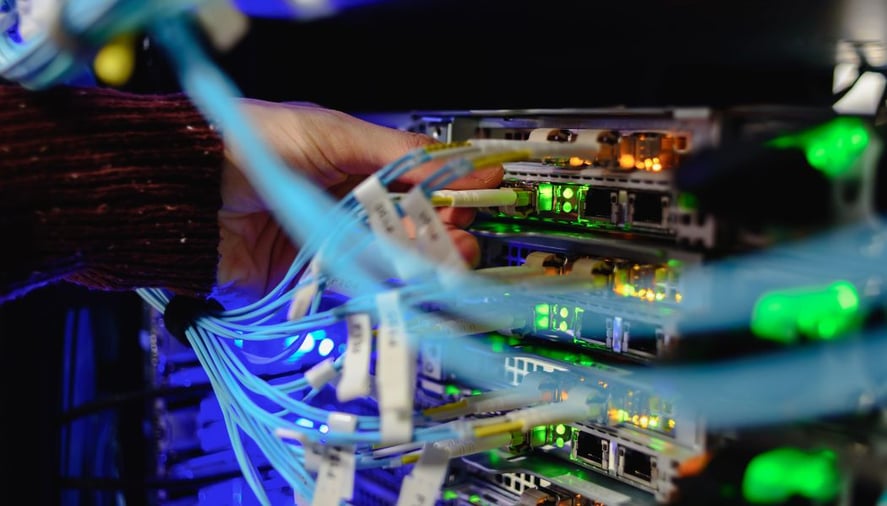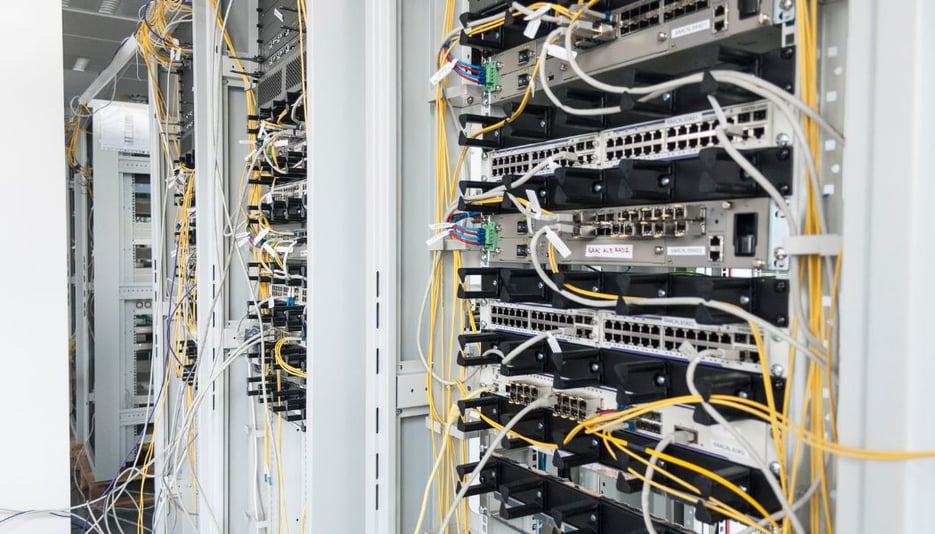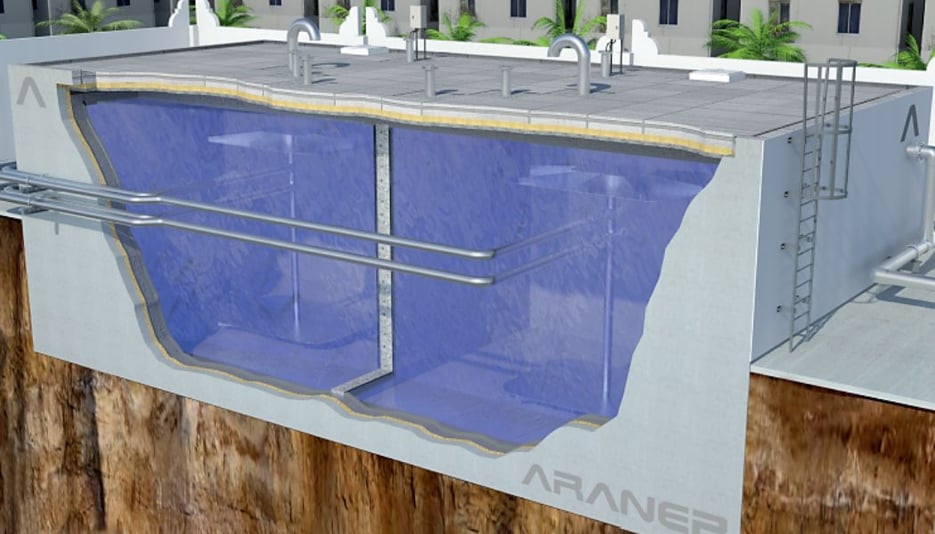Liquid immersion cooling has gained traction as an efficient alternative to cooling in data centers more efficiently and sustainably than traditional methods.
In fact, liquid immersion cooling can be up to 1000 times more effective as part of data center cooling solutions than systems based on air cooling techniques.
But what exactly is liquid immersion cooling and what are its advantages when it comes to data centers? At ARANER, we’ve compiled a brief guide about the current role of the immersion cooling system as part of data center technology, including a definition and description of the method. Keep reading to learn more about this promising approach to cooling technologies.
What is liquid immersion cooling?
The term liquid immersion cooling describes the process of submerging informatic equipment in a dielectric, thermally-conductive liquid with the aim of reducing its temperature.
Liquid immersion cooling takes many shapes and forms. Firstly, it can be applied to a wide variety of systems, from computer components (hardware) to full servers.
Additionally, it can be done on a small, simple scale (for instance, a computer enthusiast submerging hardware in mineral oil to cool it); as well as as part of more sophisticated, innovative operations taking place to guarantee optimal performance at data centers.
It’s also important to consider there are different methods and types of liquids that can be employed when performing liquid immersion cooling, while they all have in common their dielectric properties as well as the fact that they’re thermally conductive.
The technique, also known as liquid submersion cooling, builds up from liquid cooling techniques, which employ pumps and external radiators. In the case of liquid immersion the heat exchange between the warm coolant and cool water circuit takes place by means of a heat exchanger (such as a radiator).
Difference between liquid immersion cooling and water cooling
A differentiation between liquid immersion cooling and water cooling is also needed.
- Immersion cooling is based on removing heat (transferring) away from the source of heat (the electronics) by means of the working fluid. On the contrary, as water cooling employs a fluid that is harmful to electronics, the liquid is flown through a sealed, watertight loop that is isolated from the source, so that the removal of heat takes place in an indirect manner.
In the case of immersion cooling, the fluid typically consists of transformer oils or electrical cooling oils, with non-purpose oils having been successfully employed.

How effective is liquid immersion cooling?
Liquid immersion cooling has been increasingly adopted as an efficient alternative to fulfill cooling needs in data centers. The reason behind this adoption lies in this method’s advantages in terms of efficiency, considering liquids are more efficient conductors for heat than air.
This efficiency is extended when it comes to cooling particularly potent computer equipment. In the case of servers, for example, as this equipment increases its power, so does the heat it generates. At this point, it’s worthwhile considering liquid immersion cooling as the preferred method.
For instance, power densities above 15 kW per rack will benefit from the proven increase in energy efficiency that liquid immersion cooling can provide.
Other sources of efficiency when considering an immersion cooling system can be summed up as follows:
- Liquid immersion cooling provides up to 99% savings in electricity uses compared to traditional cooling methods employing chillers, heat pumps or HVAC solutions.
- Different systems, such as the simplest open bath methods, provide lower operational costs, thus generating savings in resource employment
- Compared to water cooling, liquid immersion cooling removes the inconvenience of having to rearrange plumbing systems
- This method also adds efficiency in terms of data center design as well as potential disaster recovery planning, as issues such as rust, leakages or risks related to combining electrical systems and water are removed from the equation
However, when it comes to considering liquid immersion cooling efficiency, it must be noted that not all liquid immersion cooling options are the same. The selection of the right cooling system for a data center must take into account cost efficiencies, the types of technologies that match systems at the particular data center, as well as installation, maintenance and management requirements. It’s only through this holistic approach, as well as considering the particular needs of each project, that the maximum efficiencies can be achieved.

What are the benefits of using liquid immersion cooling?
- Lower operational costs: liquid immersion cooling can significantly decrease the cost of cooling data centers, which can amount to serious quantities. In fact, cooling can thus become a key factor in the expenses that operators can control and have an influence on.
- Increased reliability: cooling needs in data centers are crucial, ensuring equipment can run in an optimized and reliable manner. This is especially true considering the increasing demand for power capacities in High-Performance Computing (HPC) contexts in data centers, which have increased power demand ten times.
- Improved control: liquid immersion cooling allows operators to direct cooling operations to specific equipment or areas (for instance, the most critical ones, such as processors). This makes a significant difference with other traditional cooling solutions based on air, which is less easily directed and may encounter problems while traveling through servers.
Liquid immersion cooling: its role in data centers
As we’ve mentioned across the article, data centers are currently the main receivers of the benefits of liquid immersion cooling. As modern society increasingly relies on data centers, companies have been looking for ways to make these energy-intense structures more efficient and sustainable.

While Facebook and other far-reaching companies can afford to move their data centers to cold regions such as the Arctic, others must find a way to make cooling reliable and cost-effective in less extreme locations. In fact, other projects, such as ARANER’s success case study at the Al Ashghal Data Center, involve generating efficient cooling in locations where warm temperatures are the norm.
Outside temperatures are not the only challenge that data centers are facing: as these structures increase their rack densities to meet larger processing needs, energy and electricity consumption also grows. This expansion can only be countered by finding energy-efficient alternatives to their processes, and liquid immersion cooling stands at the center of these, allowing operators to directly and efficiently cool down hardware.
At ARANER, we’ve grown to become an undisputed leader in large-scale pioneering cooling solutions. As such, we offer guidance through the design and installation process of data center cooling systems. Want to find out more about the possibilities of liquid immersion cooling for data centers? Download our free Data Center Reference ebook or get in touch with us and speak to our team about your needs.










